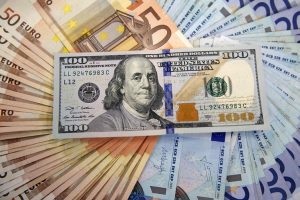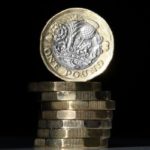 Yesterday’s trade saw EUR/USD within the range of 1.1291-1.1387. The pair closed at 1.1303, retreating 0.48% on a daily basis, or the most since April 13th. The daily high has been an exact test of the high from April 19th. EUR/USD has depreciated 0.74% so far during the current month, following two consecutive months of advance. In March it went up 4.66%, or the most since September 2010, when the pair added 7.46% to its value.
Yesterday’s trade saw EUR/USD within the range of 1.1291-1.1387. The pair closed at 1.1303, retreating 0.48% on a daily basis, or the most since April 13th. The daily high has been an exact test of the high from April 19th. EUR/USD has depreciated 0.74% so far during the current month, following two consecutive months of advance. In March it went up 4.66%, or the most since September 2010, when the pair added 7.46% to its value.
At 6:39 GMT today EUR/USD was edging down 0.10% on the day to trade at 1.1292. The pair touched a daily high at 1.1306 during early Asian trade, undershooting the daily R1 level, and a daily low at 1.1288 again during the early phase of the Asian trading session.
On Thursday EUR/USD trading may be influenced by the following macroeconomic reports and other events as listed below.
Fundamentals
Euro area
ECB policy decision
At 11:45 GMT the European Central Bank (ECB) is to announce its decision in regard to borrowing costs. The median estimate by experts suggests that the central bank will probably leave its benchmark interest rate intact at the record low level of 0% at the policy meeting today. The bank last reduced the refinancing rate by 5 basis points to the current 0% at the March 10th 2016 meeting. The ECB will probably also leave the rate on the deposit facility intact at -0.40%. The rate was last reduced by 10 basis points to its present level at the March 10th meeting.
In March, the marginal lending facility rate was cut by 5 basis points to 0.25%, while the scale of the ECBs public and private sector asset purchasing program was expanded from EUR 60 billion to EUR 80 billion. The program is intended to run until at least March 2017 or beyond, if macroeconomic conditions require it. The March Monetary Policy Accounts revealed that policy makers did not rule out rate cuts in the future, if new shocks altered inflation outlook.
According to extracts from the Account of the March 9th-10th policy meeting of the ECBs Governing Council: ”Members widely agreed that, while the recovery of the euro area economy was expected to proceed, euro area growth momentum would be slower and inflation lower for longer than previously anticipated. This implied yet another postponement of the date by which inflation was expected to return to rates in line with the Governing Council’s medium-term aim.”
”Most members favoured the proposed cut of 10 basis points, in conjunction with maintaining the formulation of “at present or lower levels” in the Governing Council’s forward guidance. It was argued that, from today’s perspective, and taking into account the support provided by the policy measures to growth and inflation, policy rates would be expected to remain at very low levels and that further rate reductions would not be anticipated at this stage.”
The interest rate decision is to be followed by the press conference with ECB President Mario Draghi, during which volatility of the currency pairs containing the euro usually heightens. In case Draghi offers a more hawkish tone, the euro will usually receive support, while a more dovish tone will have a bearish effect on the currency. The press conference is scheduled at 12:30 GMT.
United States
Initial, Continuing Jobless Claims
The number of people in the United States, who filed for unemployment assistance for the first time during the business week ended on April 15th, probably increased to 263 000, according to market expectations, from 253 000 in the preceding week. The latter has been the lowest number of claims since November 1973.
The 4-week moving average, an indicator lacking seasonal effects, was 265 000, marking a decrease by 1 500 compared to the preceding weeks revised down average.
The business week, which ended on April 8th has been the 58th consecutive week, when jobless claims stood below the 300 000 threshold, which suggested a healthy labor market.
Initial jobless claims number is a short-term indicator, reflecting lay-offs in the country. In case the number of claims met expectations or increased further, this would have a moderate bearish effect on the US dollar.
The number of continuing jobless claims probably remained steady at the seasonally adjusted 2 171 000 during the business week ended on April 8th, according to the median forecast by experts. The latter represented a decrease by 18 000 compared to the revised down number of claims reported in the week ended on March 25th. This indicator reflects the actual number of people unemployed and currently receiving unemployment benefits, who filed for unemployment assistance at least two weeks ago.
The Department of Labor is to release the weekly report at 12:30 GMT.
Philadelphia Fed Manufacturing Survey
The Philadelphia Fed Manufacturing Index probably slowed down to a reading of 8.9 in April, according to the median forecast by experts, from 12.4 in March. The latter has been the highest index level since June 2015, when the gauge was reported at 15.2. The index is based on a monthly business survey (the Business Outlook Survey), measuring manufacturing activity in the third district of the Federal Reserve, Philadelphia. Participants give their opinion about the direction of business changes in overall economy and different indicators of activity in their companies, such as employment, working hours, new and existing orders, deliveries, inventories, delivery time, price etc. The survey is conducted every month since May 1968. The results are presented as the difference between the percentages of positive and negative projections. A level above zero is indicative of improving conditions, while a level below zero is indicative of worsening conditions. In case the index slowed down more than projected, this would have a moderate bearish effect on the US dollar. The Federal Reserve Bank of Philadelphia is expected to release the official results from the survey at 12:30 GMT.
CB Leading Economic Index
The Conference Board Leading Economic Index for the United States probably continued to increase in March, going up at a monthly rate of 0.4%, according to the median estimate by experts. In February the index ticked up 0.1%, following two straight months of decline.
It encompasses a variety of economic indicators, which signify possible changes in overall economic activity. The index is comprised by the following components: average weekly hours in manufacturing, average weekly initial claims for unemployment insurance, manufacturers’ new orders, consumer goods and materials, ISM Index of New Orders, manufacturers new orders, non-defense capital goods excluding aircraft orders, building permits, new private housing units, Stock prices, 500 common stocks, Leading Credit Index, interest rate spread, 10-year Treasury bonds less federal funds, average consumer expectations for business conditions. A better-than-expected performance of the index would have a moderate bullish effect on the US dollar. The Conference Board research group will release the official report at 14:00 GMT.
Daily and Weekly Pivot Levels
By employing the Camarilla calculation method, the daily pivot levels for EUR/USD are presented as follows:
R1 – 1.1312
R2 – 1.1321
R3 (range resistance) – 1.1330
R4 (range breakout) – 1.1356
S1 – 1.1294
S2 – 1.1285
S3 (range support) – 1.1277
S4 (range breakout) – 1.1250
By using the traditional method of calculation, the weekly pivot levels for EUR/USD are presented as follows:
Central Pivot Point – 1.1327
R1 – 1.1423
R2 – 1.1562
R3 – 1.1658
S1 – 1.1188
S2 – 1.1092
S3 – 1.0953





